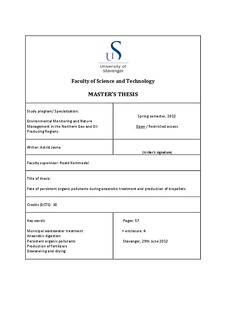| dc.description.abstract | Treatment of municipal wastewater produces large quantities of sludge that represents a cost for the individual wastewater treatment plant. Proper sludge treatment enables reuse of sludge, possibly as fertilizers. Fertilizer application of sludge is desirable since it improves the organic material reconstitution of the soil and implies recycling of nutrients. Negative aspects of sludge reuse are accumulation of persistent organic pollutants (POPs) in the sludge, and fertilizers based on sludge can therefore be a source of pollution. At present, there are only regulations regarding heavy metals (HMs) for sludge reuse in Norway, however, more stringent requirements is inevitable as the European Union is currently working on a document on sludge and sludge utilization where maximum levels of other pollutants in fertilizers, such as polycyclic aromatic hydrocarbons (PAHs) and polychlorinated biphenyls (PCBs), will be determined. In this thesis, fate of POPs during the processes leading to bio pellets production at the municipal wastewater treatment plant Sentralrenseanlegg Nord-Jæren (SNJ) was examined. Fate of POPs and HMs in anaerobic digesters was determined based on modeling of PAH’s partitioning between sludge particles and water phase using the software AQUASIM. An experiment was conducted to evaluate the distribution of POPs and HMs in the processes of centrifugation and drying. Analyses of samples of spiked sludge, dewatered sludge, reject water, and dried sludge were done externally by Eurofins.
Modeling of partitioning of PAHs between sludge and surrounding aqueous phase showed an approxumate setting of equilibrium within the first 10 hours after which almost all of the PAHs were found sorbed to the sludge. Experimental work showed that during the processes of dewatering THC (total hydrocarbon), PAH, PCB, and HM were all tightly bound to sludge whereas BTEX (benzene, toluene, ethylbenzene, and xylene) was found to follow the reject water. During drying almost all remaining BTEX evaporated whereas THC, PAH, PCB, and HM were found in elevated quantities in the dried sludge, i.e. bio pellets. | no_NO |
